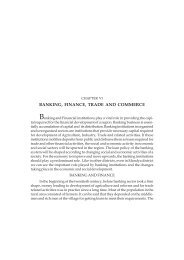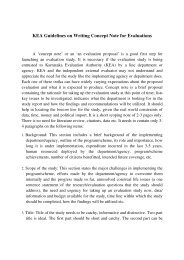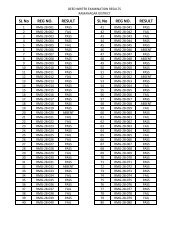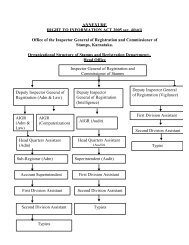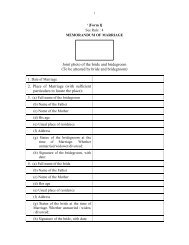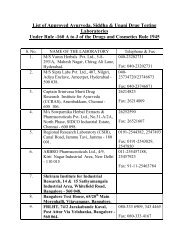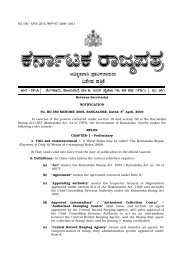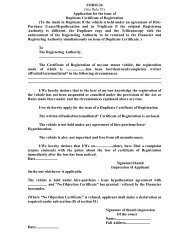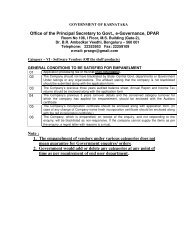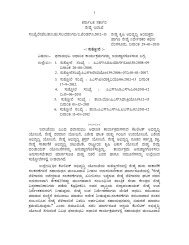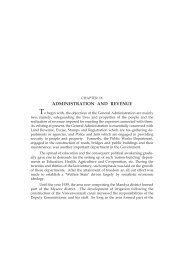Chapter XIII CULTURE - Government of Karnataka
Chapter XIII CULTURE - Government of Karnataka
Chapter XIII CULTURE - Government of Karnataka
Create successful ePaper yourself
Turn your PDF publications into a flip-book with our unique Google optimized e-Paper software.
A Handbook <strong>of</strong> <strong>Karnataka</strong> 488<br />
Appaneranda Appachcha who wrote<br />
many Kodava plays and Nadikeriyanda<br />
Chinnappa compiled ‘Pattole Palame’<br />
and translated ‘Bhagavad Gita’ were<br />
pioneering writers in Kodava language.<br />
After the merger <strong>of</strong> Kodagu with<br />
<strong>Karnataka</strong>, there is a great literary<br />
awakening. Dr. I.M.Muthanna who is<br />
the author <strong>of</strong> ‘A Tiny Model State <strong>of</strong><br />
South India’ and many other books<br />
has published a collection <strong>of</strong> poems in<br />
Kodava language. B.D. Ganapathy has<br />
Folk Dance in Kodavas<br />
written two books in Kodava Language called ‘Nanga Kodava’ and ‘Kuttambolicha’.<br />
His Kannada book on Kodava culture ‘Kodagu mattu Kodavaru’ has won him<br />
the State Academy Award. Recently, efforts are being made to foster Kodava<br />
literature and the Kodava Thak Parishat was established in 1978. It is working<br />
to bring out a Kodava lexicon. The first conference was presided over by the<br />
noted writer B.D.Ganapathi. It is holding conferences every year.<br />
Kodava has a very rich folk tradition. Kodava folk songs depict the facets<br />
<strong>of</strong> their colourful life and the poems are both robust and humorous. In these<br />
songs, we can see the Kodava language with its pecularities. These songs seem<br />
to be very old, being <strong>of</strong> a bygone age and their authors are unknown. The<br />
difference between the language used in these songs and the present spoken<br />
language is striking. The Kodavas, above all, loved their land and we find their<br />
songs begin with patriotic praise <strong>of</strong> their land. Thus, Kodavas have a unique<br />
language, culture and tradition.<br />
I.M.Muthanna, noted writer from Kodagu has completed a ‘Kodava-Kannada<br />
Nighantu’ in Kannada. Starting <strong>of</strong> ‘Brahmagiri’ weekly in Kodava language<br />
(1980) from Virajpet and ‘Jamma Nangada’ (1983) from Gonikoppal, he gave<br />
a great fillip to writing in the Kodava language apart from the publication <strong>of</strong><br />
books, but all these publications are in Kannada script. A feature film titled<br />
‘Nada Mann Nada Kool’ made in Kodava language and directed by S.R.Rajan<br />
was released in 1972. In 1994 Kodava Akademy was founded by the State<br />
<strong>Government</strong>. The Academy has honoured 75 persons with Annual Awards upto<br />
2006 and functioning from Madekere.<br />
Konkani in <strong>Karnataka</strong><br />
Konkani which is an independent language is spoken by more than 15<br />
lakh people mostly spread all over the Western coast <strong>of</strong> India, <strong>of</strong> which more<br />
than six lakhs are in <strong>Karnataka</strong>. The Konkani-speaking people were mostly<br />
living in Goa but after the annexation <strong>of</strong> Goa by the Portuguese, many <strong>of</strong> them<br />
fled to Dakshina and Uttara Kannada fearing conversation to Christianity. At<br />
present, there is a large concentration <strong>of</strong> Konkani speaking people in South<br />
and North Kanara districts including Udupi district <strong>of</strong> <strong>Karnataka</strong>. Even though<br />
the Konkani language and culture were supressed by the Portuguese, the<br />
people who migrated from Goa managed to help their culture to flourish. In the



